

Since the last issue of the Newsletter was published, some changes have taken place. The Computing Facilities Technical Advisory Group's (CFTAG) review of the Common Base Policy (CBP) has replaced the CBP with EASE - Engineering Applications Support Environment. A short article outlines the review and the new EASE Policy.
Bill Trowbridge, Head of the Computing Applications Group in the Technology Division at RAL, has now left to become full-time Chairman of Vector Fields Ltd. This has led to his Group being integrated with the Engineering Computing Facilities Group of the Informatics Division,to form the Engineering Computing Group, led by Mike Jane. More details are given below.
Four Workshops are being arranged for the Engineering Computing community, the first one being held in September. Details are given in the article on the Applications Software Programme Review and also in Forthcoming Events.
Bill Trowbridge, who was Head of the Computing Applications Group in the Technology Division at RAL, left the Laboratory on 30 June to become full-time Chairman of Vector Fields Ltd., an Oxford based company he set up in 1984 to market the electromagnetics and other software developed by his RAL Group.
Bill joined the Laboratory in 1957 after a career in the Merchant Navy. He became involved with mathematical and computational aspects of the design of complex equipment, including the High Field Bubble Chamber.
In 1971, he set up the Computing Applications Group and built up a team specialising in the simulation of electromagnetic devices, and other applications in Engineering Sciences. He was Chairman of the first COMPUMAG Conference on the Computation of Electromagnetic Fields in 1976.
In 1979, he became a Fellow of the Institute of Electrical Engineers and was awarded the Maxwell Premium with his colleague, John Simkin, in 1982, for his paper on 3-D Non-linear Electromagnetic Field Computations.
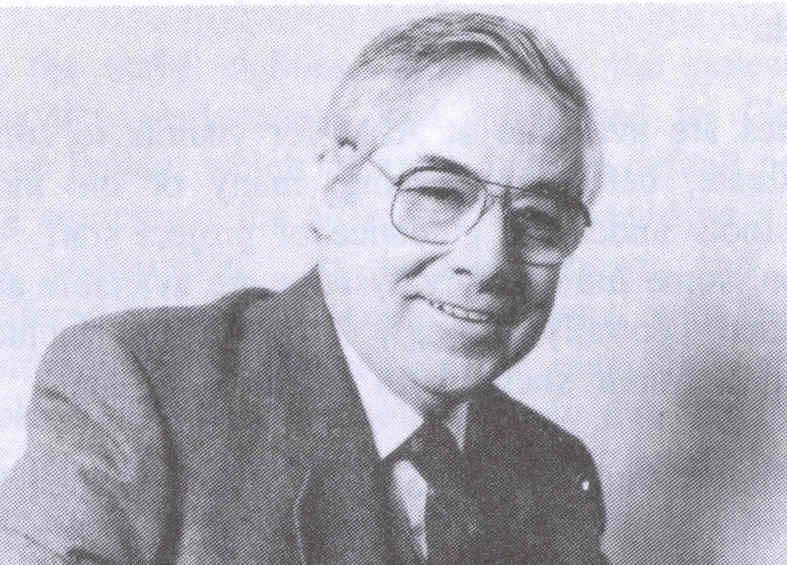
Since 1976, Bill has been closely associated with the Interactive Computing Facility (ICF) and has been responsible for Engineering Applications, funded by the Engineering Board's Computing Facilities Committee (CFC) since 1981. He has also been Project Leader of two projects funded by the European Commission on numerical simulation of semi-conductor devices.
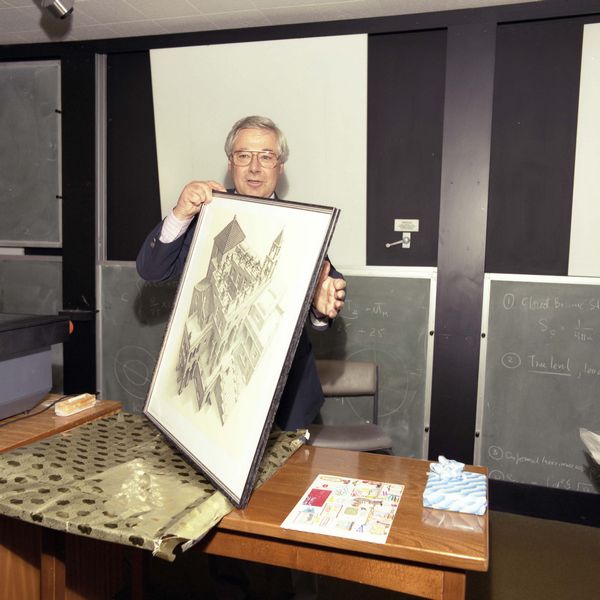
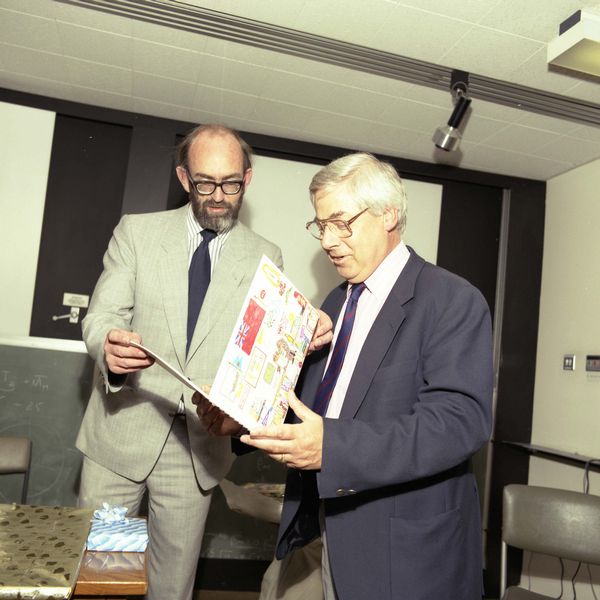
A contract has been established with Vector Fields to provide support for their commercial software on the ICF Prime machines. Vector Fields has already received a million dollar award for its sales of TOSCA, and has a contract from the European Commission's ESPRIT Programme for the use of parallel computers in Computer Integrated Manufacturing. The Company has already made a good start and we wish Bill and his colleagues every success in the future.
On Bill's departure, the opportunity was taken to combine the Computing Applications Group with the ECF Group headed by Mike Jane to form a new Group, Engineering Computing Group, in Informatics Division from 1 July. This means that all the activities funded by the CFC at RAL are now focussed in a single Group. More details of the reorganisation will be given in the next issue of the Newsletter.
Members of the Knowledge Representation and Expert Systems group at the AI Applications Institute, Edinburgh University (AIAI), are working on a CFC contract to provide support to SERC funded researchers and students who wish to investigate the application and applicability of AI to their own engineering problems. This article describes some of the services available and some of our current activities.
Getting started with AI tools and techniques can be a major problem. Although a large selection of products now exists, making an appropriate choice is difficult.
Facilities are available at AIAI for visitors to come to evaluate, before purchasing, many of the most useful tools under the guidance of project staff. In addition, some introductory systems are available and distributed centrally through RAL. These include two expert system shells, both written in Prolog:
Both CRESS and the Blackboard Shell run under Edinburgh Prolog, which is also available through RAL; they also run under C-Prolog. In addition, the Blackboard Shell can be run under Poplog Prolog.
CRESS is a backward chaining shell and is very easy to use. The Blackboard Shell is a more sophisticated forward chaining shell which provides a means of organising data and communication between several knowledge sources. (A blackboard system is so called by analogy with a system of human experts in different areas cooperating in the solution of a problem which none of them alone could achieve. In order to organise the process they agree to communicate by using a blackboard which they can all read and on which each may write partial results.)
Knowledge is represented in both systems by rules of the form:
if condition then conclusion
Further knowledge can then be gained through either of two mechanisms: backward chaining and forward chaining.
Backward chaining works backward from the conclusion, trying to show that all the necessary conditions are true. Hence it is also called goal-directed inference. Forward chaining means drawing a new conclusion whenever suitable conditions are satisfied. When all the conditions of a rule are true, the conclusion is added to the stored knowledge; this new piece of information may be a condition for further conclusions, causing more rules in the system to be triggered, asserting new information, and so on. Forward chaining is also called data-driven inference.
Several courses are available in Edinburgh. So far courses on LISP and more advanced KBS development systems (including Inference ART, KEE, Knowledge Craft and LOOPS) have been given. These are repeated regularly and further courses on expert systems and Prolog are being added. The following course dates are known; others will be advertised as they become available.
At the moment we have two workshops planned: one specifically for civil engineers; the other for all who are interested in building expert systems. The civil engineering workshop, entitled The Way Forward, will provide a forum for civil engineers to meet, identify possible application areas for AI and to discuss the potential of AI in civil engineering. The other workshop, entitled 'AI Tools, will address issues relating to the kinds of AI tools that are required by engineers. Both workshops are expected to take place in Edinburgh during the first term of the next academic year. If you are interested in coming to either of these, please let us know as soon as possible because each workshop will be restricted to about twenty five attendees. If you have ideas on workshops that you would like us to organise please pass suggestions on to us.
AI seminars are held regularly at Edinburgh University. If you like to know about these seminars we can send you advance notices. Alternatively, members of the project team are happy to visit you at your own site and give a short presentation of current work and to discuss the applications of AI with you and your colleagues. Please contact us to make arrangements if you are interested.
Titles and abstracts of some of our talks at present are:
Graphics workstations provide a base for constructing software that is much easier to use. For example, the user of good workstation software can manipulate objects on the screen by pointing at them, and perhaps "dragging" them around. No command language is needed, and, when the user points at an object, he or she gets feedback on the nature of the object and what operations can be performed on it. Information can be managed effectively using pop-up displays, and can be enhanced by graphical representations of the current context and the current state of progress. In short, a graphics workstation provides a much higher bandwidth of communication between human and machine, and as a result is leading to a new generation of highly interactive software products. The advantages of this highly interactive approach apply even when the objects being manipulated are textural rather than graphical.
Nevertheless, the graphics workstation is not a magic recipe for good software: there are plenty of software developers who, when given extra freedom, duly hang themselves. The more dimensions there are to the human interface, the harder it is to get it right.
In the early eighties, SERC saw the potential of graphics workstations and introduced its Common Base Policy, which planned that the default computing equipment for all researchers would be a graphics workstation. As is well known, this Policy suffered from considerable problems with the early hardware and software, but the main fault with the Policy itself was, we believe, only that it was ahead of its time. Recently, the Policy has been made more flexible and adaptive, and has evolved into Engineering Applications Support Environment EASE. Hardware and software are now vastly improved, and the advantages of the original Policy are now being exploited.
Following on from this Policy, the University of Kent was commissioned in 1983 to act as a Software Tools Centre for graphics workstations. The aims of the Centre were (and still are):
The original contract ended in 1986 and its aims were, we believe, fully met. A range of tools has been developed and are seeing increasingly widespread use, particularly on the Sun3 workstation. Every deadline was met, and user reaction was sufficiently favourable to convince SERC to renew the work for a further three years.
The most popular tools are:
All of these tools run under Unix and have been written in a way that allows them to be ported to any Unix workstation. Perhaps the greatest lesson learned from their development is that successful highly interactive tools are not simply previous tools tarted up, but involve a complete rethink on how users should communicate with a computer. As a result, the work has produced several novel approaches on presenting information to the user in a clear and easily-manipulated way.
The general flavour of the tools is well illustrated by the file comparator tool, vdiff
Unix itself supplies a file comparator tool, called diff, which is neither graphical nor interactive. Figure 1 shows an sample of its output, which can hardly be claimed to be friendly. The aim of vdiff is to put a friendly face onto diff by presenting its output in a comprehensible and interactive way. Figure 2 shows vdiff in use. The two files to be compared (which can be any text files, eg programs, documents, etc.) are displayed side by side. Lines are drawn between the two files to show where the differences lie. Material that is in one file but not the other is shown in bold type.
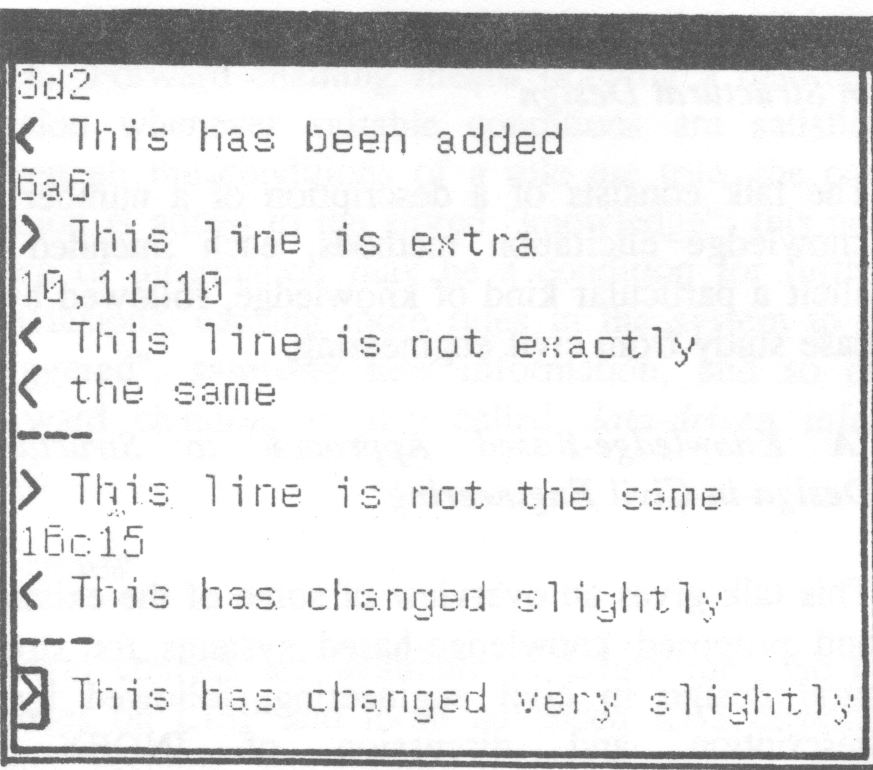
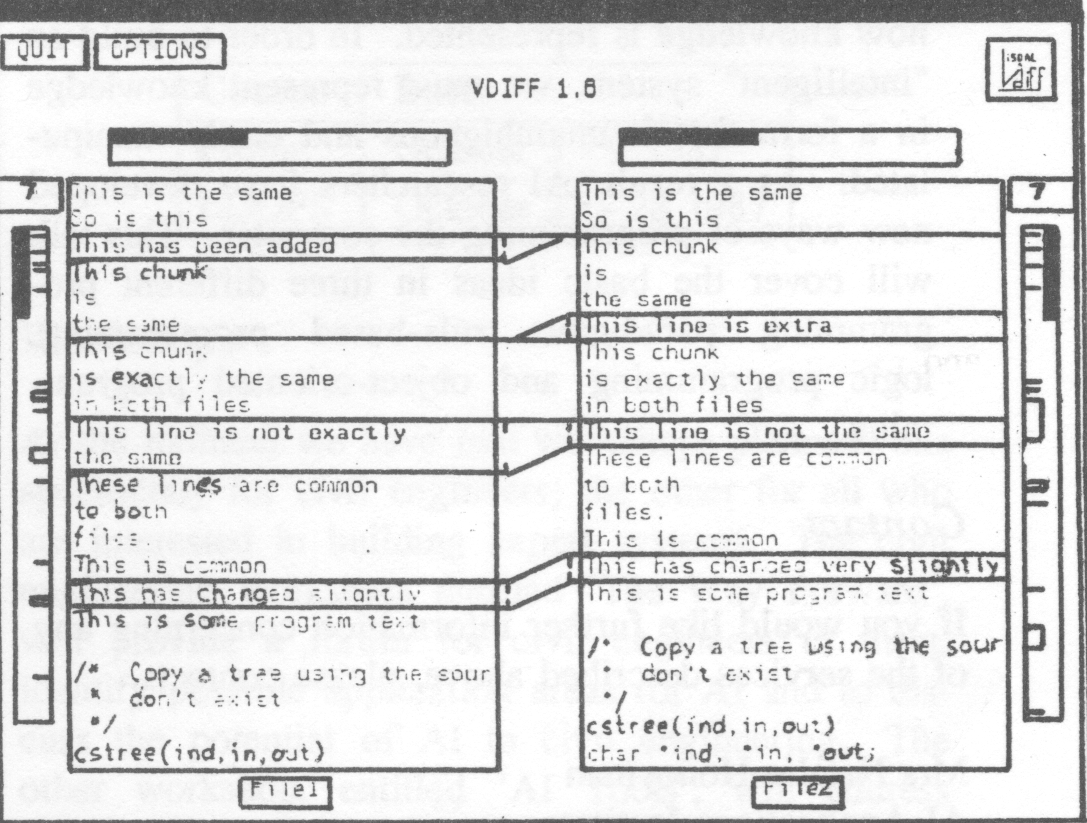
The real gain of vdiff is not, however, its presentation but its degree of interaction. The user can point at either file with the mouse, and by holding the mouse-button down, can scroll continuously through the file. Vdiff automatically keeps the two files lined up; for example if the second file has an extra one hundred lines inserted, then scrolling of the first file will temporarily stop while the one hundred lines are passed over, and will then resume when the files are in phase again. The scroll-bars (the tall rectangular areas on each side of Figure 2) show where the files are currently focused: the black part represents the part you can see, in the context of the whole file. The nicks on the inside of each scroll-bar show where the differences lie. A scroll-bar can be used to jump immediately to any of these differences.
The vdiff approach, we believe, is a dramatic improvement on diff: the user gets an immediate appreciation of the difference between files, and sees each difference in context.
Recently, the staff of the Houses of Parliament have become interested in this work, since they need to monitor the changes to Bills as they pass through Parliament. As a result, we are planning a new feature whereby vdiff secretly adds extra lines to a file without the user knowing. Our future funding may therefore come from an extra clause in an Act of Parliament, supporting us in perpetuity at a base in Tahiti with ........... .
SERC also financed at Kent University a complementary programme to the Software Tools Centre. This was the Fortran Libraries Centre, under the direction of Dr T R Hopkins, which shared the same aims as the Tools Centre but was oriented specifically to the Fortran community. This work has been equally successful, and support has been renewed in a new contract combined with the Tools Centre.
The Tools Centre has been fortunate in the quality of research staff and lecturers associated with the project: David Barnes, John Bovey, Mark Russell, Peter Siemon and Mark Wheadon. All have achieved the difficult balancing act between, on the one hand, working all hours concentrating on the minutae of implementation and, on the other, thinking in terms of the user's view of the tool rather than the tool as an end in itself.
Graphics workstations are becoming increasingly cheap and thus increasingly widespread. In the future a large part of the software market may be for highly interactive workstation software. We hope British industry obtains a good share of this market, and particularly, that SERC's early move into graphics workstations will provide the basic expertise for this.
A meeting between the ECUG Chairman, Professor N Munro, the parallel session Convenors and the ECFE staff was held at RAL on Tuesday, 30 June 1987.
Among the issues discussed was the draft policy document for the Engineering Applications Support Environment (EASE), which will form the basis of Computing Facilities Committee (CFC) strategy to replace the Common Base Policy (see next article). The Applications Software Review was also discussed and information on this activity is covered elsewhere in this Newsletter.
The next meeting of the ECUG will be held at RAL on Tuesday, 22 September 1987.
In his review of activities to the Prime User Group, the retiring Chairman, Gordon Dixon, of the Institute of Advanced Studies, Manchester Polytechnic, highlighted several points.
The Prime User Group is a broadly based research community consisting of users in Computer Aided Design/Engineering, ECAD, Control, Electromagnetics, FE analysis, Simulation, Software Development and Computing Science. It is therefore essential that applications and user support services are provided in order to meet the needs of researchers, that the Group has fostered.
Pressure from the User Group has ensured that the development and enhancement of both the hardware, in terms of processor and peripheral upgrades, and software has matched user needs. CPU power has been enhanced by over 50% since 1984, and now only single versions of the Fortran and Pascal libraries exist. Other enhancements include graphics (GKS, with anticipated additions of 3D). The introduction of the Job Transfer Manipulation Protocol (JTMP) to supplement JNT mail and FTP has offered the community full networking capability to all machines offering these facilities.
Current developments include the evaluation of a Unix service based upon Prime's PRIMIX system which runs on top of the standard PRIMOS. This would allow the development and eventual transfer of application programs to run under this emerging universal operating system.
In the near future, user groups that are software-orientated rather than hardware-orientated are likely to dominate research. For many researchers, hardware has simply become a carrier for the software they use. The Prime User Group has encouraged this process of consolidation, but also has ensured that the user's voice has been, and will continue to be, heard by the Engineering Board through its User Group and CFTAG.
Since it was established in late 1986, the Computing Facilities Technical Advisory Group (CFTAG) has conducted a review of the Common Base Policy (CBP). There were several reasons why this needed to be done:
In view of this, CFTAG has discussed a new policy called the Engineering Applications Support Environment (EASE). The Computing Facilities Committee (CFC) has agreed the overall direction and will see the complete policy document for approval in October.
The EASE policy recognises that users' requirements vary from the person who needs specific application packages to the person who writes his or her own software using basic software and hardware. The document also recognises that any particular user only requires a small proportion of the components that make up EASE. The underlying software and hardware will differ depending on the subset of interest.
The EASE policy currently covers a range of processing facilities including single user systems, multi-user minis and personal computers. The policy also introduces a distributed infrastructure, which the processing facilities may access; this includes a Central Server Facility, local specialised computing and shared use of remote facilities.
The policy will be defined by means of a general purpose policy document and a series of specific schedules which define the supported components.
The draft EASE document is now available for comment by users (at this stage without the specific schedules).
The Engineering Board has actioned its Computing Facilities Committee (CFC) to carry out a further review of its applications software programme with a view to making it more responsive to the Subject Committees' programmes...
This review, to be completed by mid 1988, is being coordinated by CFTAG.
CFC is responsible for those computing matters which are of interest to more than one Subject Committee. As part of a future programme in applications software, a proposal was presented to CFTAG in May to provide an integrated environment for engineering design using continuum modelling, applying to areas such as geometric modelling, structural analysis, thermal analysis, electromagnetic analysis, semi-conductor device and process modelling, etc, and especially coupled problems (eg the design of electric motors, which requires at least structural and electromagnetic analysis). This was intended to build on experience gained in ECSTASY (the environment for control system designers) and CAD*I (the EEC project in data exchange), which were described in the second and third issues of this Newsletter respectively.
CFTAG decided that wider discussions were necessary and its proposal to hold four workshops on the use within an engineering design environment of User Interface Management Systems, Databases, Methods and Tools for Integration, and Numerical Components, was accepted by CFC at its June meeting. Each Workshop will have up to 50 attendees ranging from subject experts to academic and industrial engineers. The first Workshop on UIMS will be held in Glasgow on 19-21 September 1987, and plans are in hand to hold the second on Database systems at the beginning of December. The other two Workshops will be held in the first quarter of 1988.
10 open places have been reserved for bids to attend from the Engineering Research community and details of how to make your bids are given under Forthcoming Events at the end of this Newsletter. The other 40 places are reserved for selected invitees.
This is a brief update on the Initiative. Fuller details will be given in the Mailshot due to be sent out in the next weeks.
The Loan Pool is now fully operational and a total of 23 loans have already been approved from 38 applications. Many of these loans are already installed and working. Further applications, on the TRI form, are actively encouraged.
The tender for the National and three Regional Support Centres has now closed, with a total of 22 bids received. This response is tremendous and clearly reflects the importance of this Initiative. Short listing will take place on 23 July 1987, hopefully to around 8 (ie 2 per Region). The final decision will be taken on 13 August 1987, after detailed discussions with each of the short listed sites. The National and first Regional Centre will be contracted to begin operation on 1 October 1987. The other two Regional Centres will start operation on 1 April 1988, provided the rest of the Programme is funded.
Negotiations are currently in hand to appoint two Joint Industrial Coordinators for the Initiative. This is a vital function to ensure that British Industry responds positively to the opportunities offered by the Support Centres. Hopefully, these appointments will be made within the next few weeks.
Arrangements have been made for Inmos Ltd. to give their Introduction to Occam Course at the RAL Interim Facility for Transputer Applications (IFTA) in the week beginning 3 August 1987. The places on this course have been filled from the groups who make successful Loan Pool applications (maximum 1 per group). It is intended to repeat the course, possibly elsewhere, within the next two months.
Two six-month Development Contracts have now been approved under the Programme. The first, with Professor M Delves (Liverpool University), is to carry out an evaluation of suitable numerical algorithms for multi-transputer systems. The second, with Dr D B Arnold (University of East Anglia), is to define and review an Occam binding for the Graphical Kernel System (GKS) and to implement minimal level 0a GKS system using the binding.
Priorities for further Development Contracts are currently being defined and proposals to carry out particular activities will be invited within the next few weeks.
In recognition of the Associated Support Centre role of the Daresbury Laboratory, a small Meiko Computing Surface has been provided, for one year in the first instance. This provision is intended to ensure compatibility between software developed for the Floating Point Systems T-20 installed at Daresbury (funded by the Science Board) and the Transputer systems available through the Engineering Board Initiative. In addition, access to the T-20 system is available for members of the Engineering Community. Anyone interested in following up this opportunity should contact me in the first instance.
It is still possible to have your name added to the mailing list for the Transputer Initiative. This will ensure you receive regular Mailshots plus any other relevant information. Please contact me if you are interested in being put on this list.
At its meeting on 9 July 1987, the Engineering Board approved the appointment of Professor J L Douce (Engineering Department, Warwick University) as the new Chairman of Computing Facilities Committee (CFC).
It is hoped to produce a pen picture of Professor Douce in the next Newsletter. Details of the new members of CFC will also be given next time.
This was the last meeting of the current Academic Session and the Chairman, Professor D Lewin, a number of the Committee members and the Secretary, Mr M J Hotchkiss, were attending their last meeting.
The main points to arise from the meeting were as follows:
A Conference organised by the Centre for Software Reliability to be held at the Watershed Media Centre, Bristol.